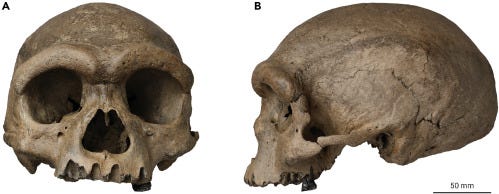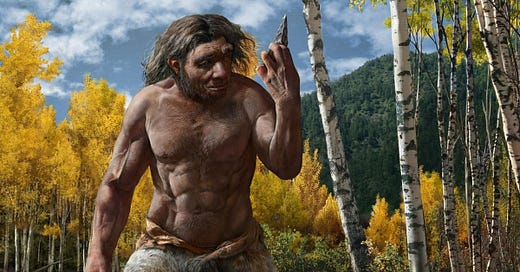According to new research published last week, the human family has gained a new member: Homo longi, colloquially called “Dragon Man,” identified from a fossilized skull found in northeastern China. The skull is at least 146,000 years old, and could be even older.
A construction laborer working in the city of Harbin discovered the skull way back in 1933, but reportedly hid it in a well to keep it out of the hands of the Japanese, who then occupied northeastern China. It remained unknown to scholars until just before the man’s death in 2018, when he revealed its existence to his family. They retrieved the skull and gave it to researchers at the Geoscience Museum of Hebei GEO University. The skull, which is incredibly well preserved for a specimen of that age (and among the best preserved for any , obviously belonged to an archaic human: It is large and robust, and quite unlike that of our particular species.

This is a pretty big deal. If the researchers who published the discovery are correct, then the skull from Harbin represents a brand-new lineage of our human family. Moreover, they argue that this newly discovered lineage, rather than that of the Neanderthals, is actually the closest relative to modern humans.
So how should we understand this new and incredibly exciting discovery? And where does Dragon Man fit into our current grasp of the deep human past? Have we found humanity’s closest ancient relative?
Let’s answer that last question first: I don’t think so.
The reason for that answer is based on the kind of analysis contained in these newly published papers. They make their arguments on the basis of skeletal morphology: basically, how the skull looks in comparison to the other fossil samples we have from the genus Homo. To be clear, it’s not like holding up a picture of the Harbin cranium next to others and making impressionistic guesses about which one it most closely resembles; instead, scholars take a variety of precise measurements and create statistical models, which then phylogenetically group the skeletal remains together. This method assumes, on a basic level, that similar skeletal measurements reflect similarity in ancestry.
The problem, as ancient DNA has shown us repeatedly in the last couple of decades, is that skeletal morphology is an inconsistent and unreliable guide to actual ancestry. Just because two things look similar doesn’t mean they’re actually related all that closely. Adaptation to conditions drives changes in skeletal morphology far more than immediately shared ancestry. Under the right circumstances - small populations under heavy pressure, which then expand rapidly afterward, for example - new adaptations can spread with incredible rapidity.


As Razib Khan points out in his excellent Substack on this topic, Neanderthals were quite wonderfully adapted for the cold conditions of northern Eurasia. Much of what looks “archaic” about them was actually a fairly recent adaptation (over a couple of hundred thousand years) in a small and often extremely inbred population facing brutal selection pressures in a harsh environment.
Just because the Harbin cranium has some more modern-human-like features than Neanderthals doesn’t mean it’s closer to us in ancestry. In essence, the family tree the researchers create on the basis of their skeletal measurements doesn’t hold up in the face of the ancient DNA evidence. DNA is a direct window into ancestry, not an assumed proxy for it. Until we have DNA from the Harbin cranium, we won’t be able to answer this question, but I strongly lean toward “no.”
So if not an entirely new species, who was Dragon Man? I think (and so do a bunch of actual experts quoted in the New York Times article on the topic) that he was what we call a “Denisovan.”
The Denisovans are an archaic human group we know almost entirely from DNA, first from a tiny finger bone found in Siberia’s Denisova Cave. Additional fossils from that cave, including a first-generation Neanderthal-Denisovan hybrid, have added to our understanding of Denisovan ancestry. So too have the traces Denisovans left in the DNA of modern human populations, like the ancestors of today’s Papuans and indigenous Australians.
We know that Denisovans existed, but we know almost nothing about them. That includes what they looked like. The most solid physical evidence for their existence is a very large and robust jawbone found in a Tibetan cave, which proteomic analysis groups with the Denisovans. A variety of archaic-looking skulls and other bits of skeletal evidence have shown up across East Asia in the past few decades, including one that looks almost exactly like Dragon Man, but precisely where they fit in the human family tree hasn’t been clear.
The best explanation for this, on the basis of the current evidence, is that these skulls - like that of Dragon Man - belong to the mysterious Denisovans. The Harbin cranium is large and robust, like that of the jawbone from the Tibetan cave. It dates to roughly the same period when we know Denisovans were living in the Altai Mountains 2,000 miles to the west. But it’s a little more complicated than that: We know that there was not one but several distinct groups of what we call Denisovans. This is because there were multiple interbreeding events between modern humans and these varied populations of Denisovans, who presumably lived all over what is today East and maybe Southeast Asia as well. These different Denisovan populations were quite diverged from one another, in genetic terms, enough that we can tell the difference between them in the traces they left in modern humans of the past and present. These groups were in turn quite distinct from the original Denisovans found in Denisova Cave.
So to me, this is the most parsimonious explanation: that the Harbin cranium, and Dragon Man, belonged to a member of one of these various Denisovan lineages that perhaps later interbred with modern humans.
But as we continue to discover, parsimonious explanations aren’t necessarily best when it comes to the complexity of the deep past. Two other things deserve mention. First, we can now be fairly certain that our modern human ancestors who left Africa weren’t the first Homo sapiens to do so. Others had come before them, interbred with the archaic humans living outside Africa - namely Neanderthals - and then disappeared. It’s possible that Dragon Man belonged to a group, perhaps a Denisovan group, that had interbred with one of these modern human populations at some point in the past.
Second, and more profound, is the series of questions raised repeatedly by Professor John Hawks over the years. Are we even right to think in terms of species? How much utility do names like Homo sapiens, Homo neanderthalensis, Homo erectus, or Denisovans really have?
What we’re talking about are populations, lineages, some of which were more closely related to each other than others over immense periods of time and geographic scales. As we get more evidence, both genetic and skeletal, we need to start thinking differently about our subjects, and about the human past more generally. (I interviewed Professor Hawks on Tides of History last August, and we spoke at length about this, if you’d like to check it out.) Some of what we call Denisovans - whose bones we haven’t yet found - probably had Neanderthal ancestors. Others may have had ancestors who were closely related to modern humans, like some Siberian Neanderthals 120,000 years ago did. Trying to force them into neat species boxes on a chart misses the actual messiness of the deep past.
Groups lived, came into contact with one another, interbred, and diverged again. Some of them died out; others met again, thousands and thousands of years later, and interbred once again. All of us today are the product of an unfathomable number of these interactions, spread out over hundreds of thousands of years. Dragon Man is simply a new addition to that complex, twisting, and perennially surprising series of stories.





You missed your chance to title this "Enter the Dragon Man".
Over the years, I read a prehistoric fiction series by Jean M Auel called Clan of the Cave Bear. It was well researched, and really ignited my interest in prehistory. While many called her works pure fiction and melodramatic, as Patrick’s guests, and many articles, like this one, really amaze me at how really close she was on many different themes of prehistory, especially this genetic mixing.